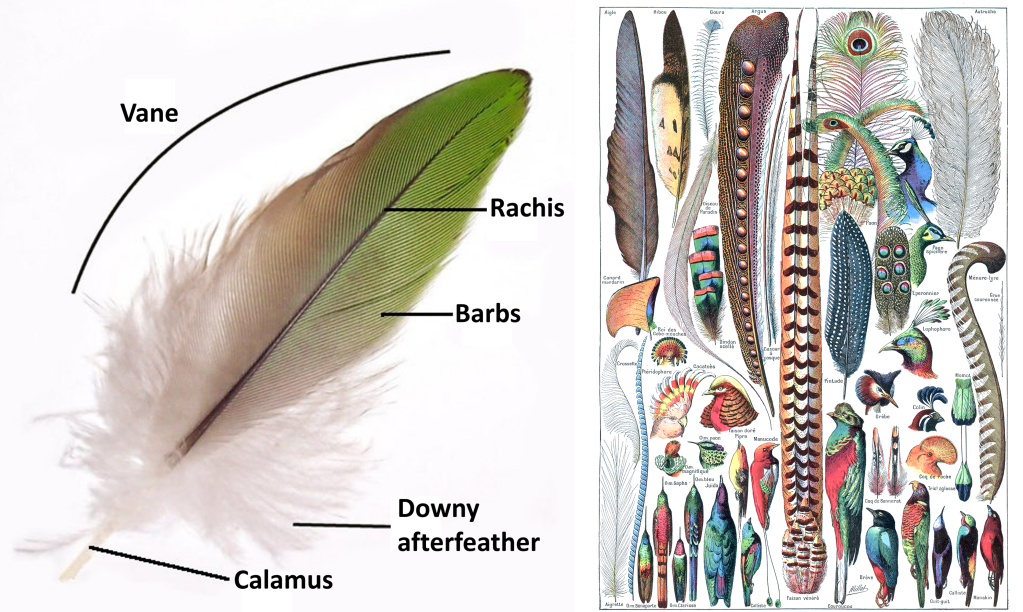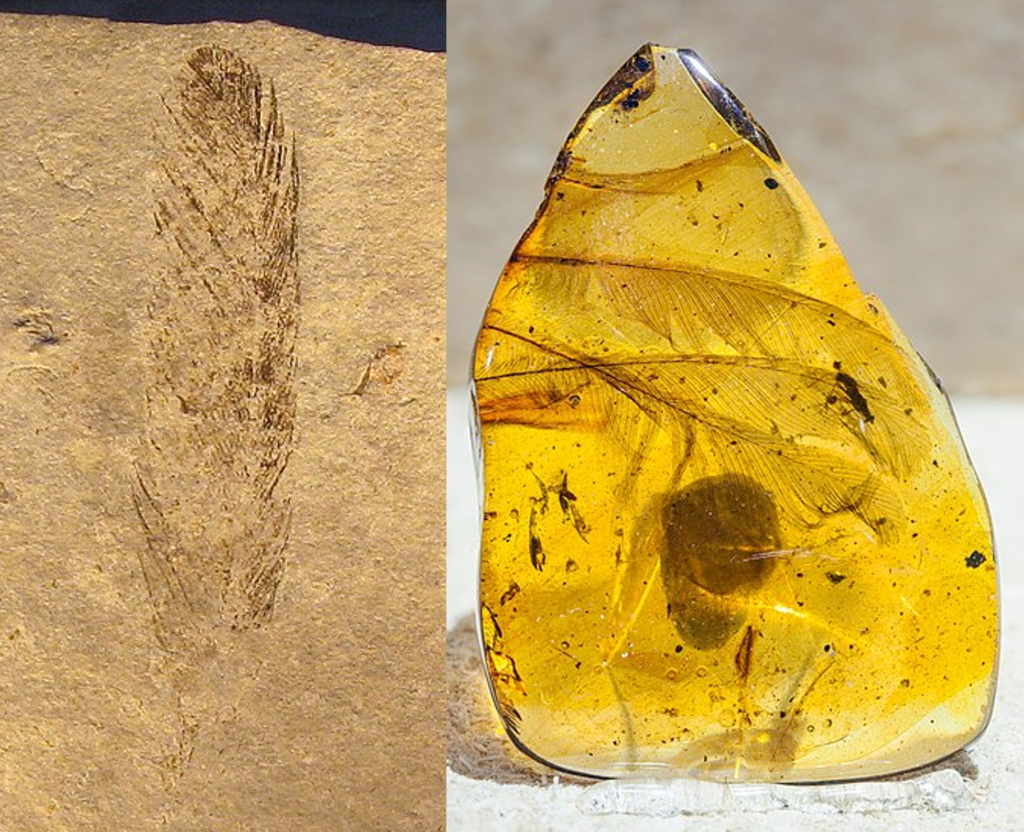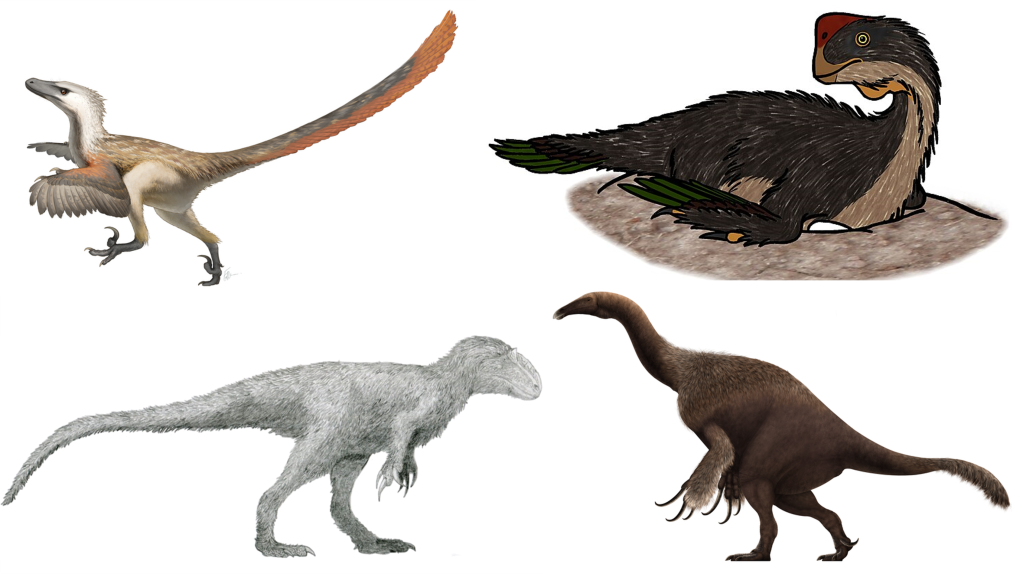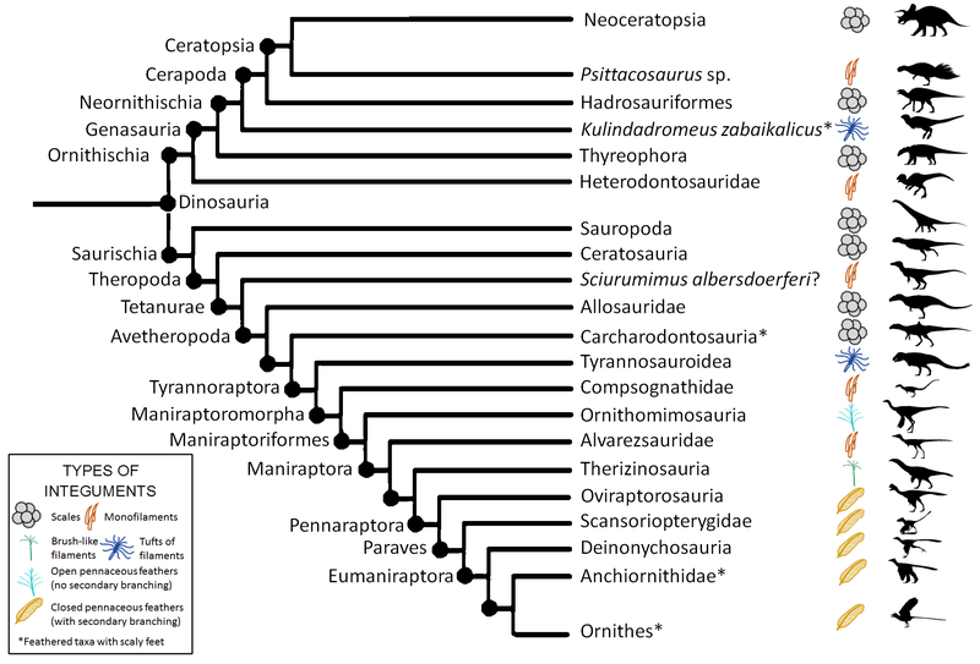Listen to Episode 183 on PodBean, YouTube, Spotify, or wherever you listen to your favorite podcasts!
They are among the most diverse and complex forms of integument, occurring in a huge variety of forms and functions on living and extinct dinosaurs. This episode, we discuss the diversity and exciting unfolding evolutionary story of Feathers.
In the news
Some Eocene birds had surprisingly sturdy neck bones
Newly discovered Cambrian worms were giant predators
Fossilized cellular structures reveal the oldest direct evidence of photosynthesis
Early Permian reptiles with the oldest known fossilized skin
Feathers
Feathers are a type of integument found exclusively (today at least) on birds. Feathers come in a wide variety of forms – broad plumes, fluffy down, short bristles, and more – and they serve a long list of functions – insulation, display, camouflage, tactile sense, flight, and plenty more.

Right: A small sampling of the diversity of modern bird feathers. Image in the Public Domain.
Feathers are similar to other integument structures like scales and hair; they develop in a similar way, their growth is regulated by similar genes, and they’re composed of similar proteins. But the details of feather origins are unclear. It might be that they derived from ancestral scales, but it’s also possible they evolved separately.

Image by Matt Martyniuk, CC BY-SA 3.0

Left: Jurassic feather compression fossil. Image by H. Raab, CC BY-SA 3.0
Right: Cretaceous feathers in amber. Image by Tiouraren, CC BY-SA 4.0
Fossil feathers are often found on fossil birds, especially in sites of exceptional preservation like the Messel Pit or Jehol. But Mesozoic fossils also reveal an extraordinary variety of feathers on non-bird dinosaurs.

Top right: Fossil of the dromaeosaur Microraptor with associated feathers much like modern birds, even including aerodynamic wing feathers. Image from Hone et al 2010, CC BY 2.5
Bottom left: Fossil of the small theropod Sciurimimus with evidence of fuzz-like feathery covering. Image by Ghedoghedo, CC BY-SA 3.0
Bottom right: Fossil of Sinosauropteryx, the first non-bird dinosaur discovered with feathers, surrounded by feathery filaments. Image by Sam, CC BY-SA 2.0

Top left: Velociraptor. Image by Fried Wierum, CC BY-SA 4.0
Top right: Oviraptor. Image by Conty, CC BY-SA 4.0
Bottom left: Yutyrannus. Image by Tomopteryx, CC BY-SA 4.0
Bottom right: Therizinosaurus. Image by PaleoNeolithic, CC BY 4.0
Several major lineages of non-bird dinosaurs are now known to be ancestrally feathered, including dromaeosaurs (the “raptor” dinosaurs), oviraptorosaurs, ornithomimosaurs, and tyrannosaurs, among others.

Top: Psittacosaurus. Image by Robert Nicholls, CC BY 4.0
Middle: Kulindadromeus. Image by Tomopteryx, CC BY-SA 4.0
Bottom: Tianyulong. Image by Nobu Tamura, CC BY 3.0

True feathers clearly evolved among theropod dinosaurs and were then inherited by birds and several related lineages. A number of more distantly-related dinosaur groups also have feather-like integument, which means either that feather-like structures convergently evolved multiple times in different dinosaur groups, or that the earliest dinosaurs already had some sort of fuzzy covering. Both options suggest feathers might be much more widespread among dinosaurs than we currently know.

Learn More
A Guide to Bird Feathers, Avian Report
Feathers Through Time, Cornell Lab
Dinosaurs Take Flight (including an overview of dinosaur feathers)
Feather Function and the Origin of Birds, 2022 paper (technical, open access)
The complex relationship between scales and feathers, 2018 paper (technical, open access)
The Early Origin of Feathers, 2019 paper (technical, paywall)
Pterosaur feathers (2022 news article)
__
If you enjoyed this topic and want more like it, check out these related episodes:
- Episode 6 – Evolution of Flight
- Episode 37 – Evolution of Birds
- Episode 79 – Pterosaurs
- Episode 120 – Tyrannosaurs
We also invite you to follow us on Twitter, Facebook, or Instagram, buy merch at our Zazzle store, join our Discord server, or consider supporting us with a one-time PayPal donation or on Patreon to get bonus recordings and other goodies!
Please feel free to contact us with comments, questions, or topic suggestions, and to rate and review us on iTunes.